Page last updated: February 2024
The information on this webpage was adapted from Understanding Head and Neck Cancers - A guide for people with cancer, their families and friends (2024 edition). This webpage was last updated in February 2024.
Expert content reviewers:
This information is based on international and Australian clinical practice guidelines for head and neck cancers. It was developed with the help of a range of health professionals and people affected by head and neck cancer:
- A/Prof Martin Batstone, Oral and Maxillofacial Surgeon and Director of the Maxillofacial Unit, Royal Brisbane and Women’s Hospital, QLD
- Polly Baldwin, 13 11 20 Consultant, Cancer Council SA
- Martin Boyle, Consumer
- Dr Teresa Brown, Assistant Director Dietetics, Royal Brisbane and Women’s Hospital, Honorary Associate Professor, University of Queensland, QLD
- Dr Hayley Dixon, Head, Clinical Support Dentistry Department, WSLHD Oral Health Services, Public Health Dentistry Specialist, NSW
- Head and Neck Cancer Care Nursing Team, Royal Melbourne Hospital, VIC
- Rhys Hughes, Senior Speech Pathologist, Peter MacCallum Cancer Centre, VIC
- Dr Annette Lim, Medical Oncologist and Clinician Researcher – Head and Neck and Non-melanoma Skin Cancer, Peter MacCallum Cancer Centre, VIC
- Dr Sweet Ping Ng, Radiation Oncologist, Austin Health, VIC
- Deb Pickersgill, Senior Clinical Exercise Physiologist, Queensland Sports Medicine Centre, QLD
- John Spurr, Consumer
- Kate Woodhead, Physiotherapist, St Vincent’s Health, Melbourne, VIC
- A/Prof Sue-Ching Yeoh, Oral Medicine Specialist, University of Sydney, Sydney Oral Medicine, Royal Prince Alfred Hospital, Chris O’Brien Lifehouse, NSW.
Head and neck cancer
Head and neck cancer is a general term for a range of cancers in the head and neck area.
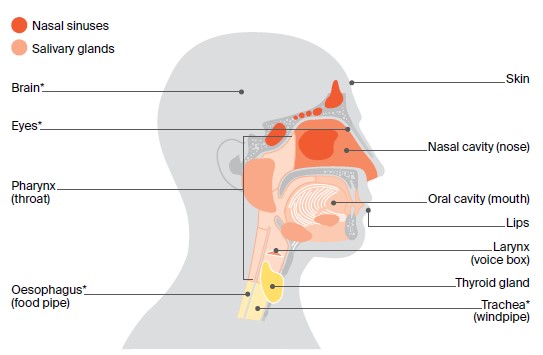
The most common head and neck cancers (about 9 out of 10) start in the moist lining of the mouth, nose or throat. This lining is called the squamous epithelium, and these cancers are called mucosal squamous cell carcinomas (SCCs).
Some less common head and neck cancers start in glandular cells, and many of these cancers are called adenocarcinomas.
SCCs and adenocarcinomas can also occur in other parts of the body. Recently, non-melanoma skin cancers (cutaneous carcinoma) that start in the head and neck area have been classified as a type of head and neck cancer.
Understanding the head and neck
In cancer medicine, the term 'head and neck' includes the:
- mouth – made up of the lips and the structures inside the oral cavity such as the tongue, Roof of the mouth (palate), jaw and gums
- throat – known as the pharynx
- voice box – known as the larynx
- nose – made up of the nasal cavity (the area inside and behind the nose) and the sinuses
- salivary glands – in the floor of the mouth, near the lower jaw and in front of the ear
- the skin – on the head and neck.
Areas that are not considered part of the 'head and neck' in cancer medicine include the:
- brain
- eyes
- thyroid – a hormone-producing gland found at the front of the neck and just below the voice box. Thyroid cancer has a different cause and is managed differently to most head and neck cancers.
- oesophagus – the food pipe
- trachea – the windpipe
- bones and muscles of the head and neck.
These areas can be affected by nearby head and neck cancers and their treatment, and can also have their own types of cancer.
The head and neck region also contains many lymph nodes, which are small, bean-shaped structures found throughout the body. They form part of the lymphatic system, which helps protect the body against disease and infection.
When cancer spreads, it usually spreads to nearby lymph nodes first.
Your guide to best cancer care
A lot can happen in a hurry when you’re diagnosed with cancer. The guide to best cancer care for head and neck cancer can help you make sense of what should happen.
It will help you with what questions to ask your health professionals to make sure you receive the best care at every step.
Read the guide
Types and related symptoms
Specific head and neck cancers are named after the area where they start. In the early stages, head and neck cancers may have no symptoms. When symptoms do occur, the most common is a lump in the neck.
There are many other possible symptoms, however these can also occur with other illnesses, so they don’t necessarily mean you have cancer – only tests can confirm the diagnosis. If you are concerned, see your doctor.
Mouth (lip and oral cavity) cancers
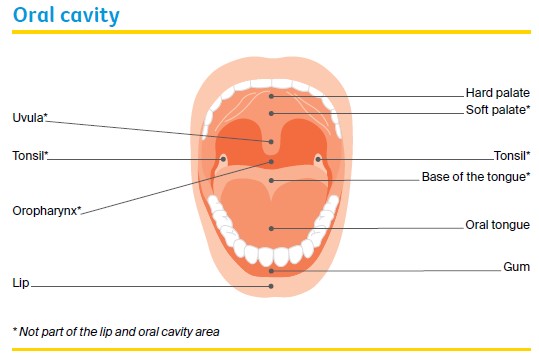
Cancer that starts in the mouth is known as oral cancer. The mouth is made up of the lips and the oral cavity, which includes the:
- gums
- lining of the cheeks and lips
- front two-thirds of the tongue (oral or mobile tongue)
- floor of the mouth (under the tongue at the front of the mouth)
- bony roof of the mouth (hard palate)
- small area behind the wisdom teeth (retromolar trigone).
The area at the back of the mouth is called the oropharynx. It includes the base of the tongue, the tonsils, the uvula and the soft palate, as well as the middle section of the throat. Cancer of the oropharynx is known as oropharyngeal cancer.
Symptoms of mouth cancers include:
- mouth pain
- pain when swallowing
- a persistent sore or swelling in the mouth, or the area not healing after having a tooth extracted
- a sore throat that doesn’t get better
- unusual bleeding or numbness in the mouth
- red or white patches on the gums, tongue or mouth
- bad breath
- changes in speech or trouble pronouncing words
- difficulty chewing or swallowing food or moving the tongue
- weight loss
- loose teeth, or dentures that no longer fit
- earache
- a lump in the neck.
Throat (pharyngeal) cancers
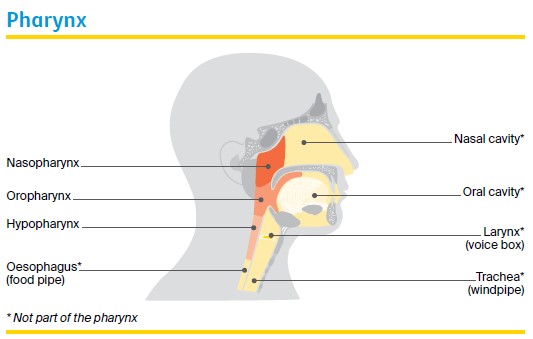
The throat, also called the pharynx, is a hollow tube that starts behind the nose and leads to the food pipe (oesophagus) and the windpipe (trachea). The pharynx has three main parts:
- nasopharynx – the upper part, behind the nose and above the soft palate. Cancer starting in this area is called nasopharyngeal cancer.
- oropharynx – the middle part, the area from the soft palate and base of the tongue to the back of the mouth, including the tonsils. Cancer starting in this area is called oropharyngeal cancer.
- hypopharynx – the lower part, around the voice box (larynx). Cancer starting in this area is called hypopharyngeal cancer.
Cancers in the three parts of the pharynx behave differently and are treated differently.
Symptoms of throat cancers include:
- a lump in the neck
- a persistent sore throat or cough
- difficulty swallowing or opening the mouth wide
- pain when swallowing
- coughing up bloody mucus
- bad breath
- weight loss
- voice changes or hoarseness
- dull pain around the neck
- earache
- feeling that your air supply is blocked
- numb face
- a blocked nose
- hearing loss
- headache.
Voice box (laryngeal) cancers
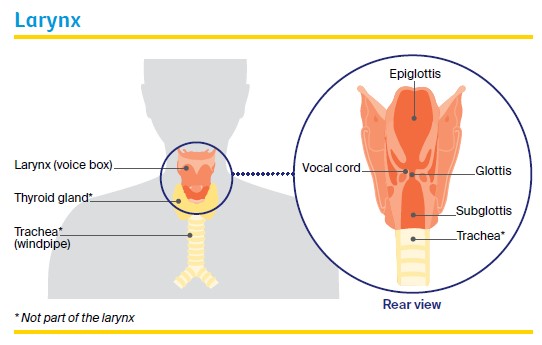
The voice box, also called the larynx, is the entry point to the windpipe (trachea). It contains the vocal cords and protects the lungs. Cancer that starts in the larynx is called laryngeal cancer. The larynx has three main parts:
- supraglottis – the area above the vocal cords. It includes the epiglottis, a small flap of tissue that covers the larynx when you swallow and prevents food and fluids going into the trachea and lungs.
- glottis – the area containing the vocal cords, which vibrate when air passes through them to produce the sound of your voice.
- subglottis – the area below the vocal cords leading to the trachea.
The thyroid gland is in front of the trachea under the voice box. It may be treated by a head and neck doctor, but thyroid cancer is not covered in this section.
Symptoms of voice box cancers include:
- a persistent change in the sound of your voice, including hoarseness
- a sore throat that doesn’t get better
- difficulty swallowing or pain when swallowing
- coughing all the time
- difficulty breathing
- weight loss
- pain in the ear
- a lump in the neck.
Nose (nasal cavity and sinus) cancers

The nasal cavity is the large, hollow space behind the nose. It is separated into two main cavities by the nasal septum, a thin wall of bone and cartilage in the centre of the nose.
The paranasal sinuses are small, air-filled spaces in the side walls of the nose. They help to warm and moisten air passing to the lungs. They also influence the sound and tone of your voice. There are four pairs of paranasal sinuses:
- maxillary sinuses – under the eyes and in the cheek area
- frontal sinuses – behind the forehead
- ethmoid sinuses – above the nose and between the eyes
- sphenoid sinuses – behind the nose and between the eyes.
Cancer that starts in the upper part of the throat behind the nose is called nasopharyngeal cancer.
Symptoms of nose cancers include:
- reduced sense of smell
- a persistent blocked nose or ear
- frequent nosebleeds
- lots of mucus in the throat or back of nose
- frequent headaches or sinus pressure
- difficulty swallowing
- loose or painful upper teeth
- a lump on or in the face, nose or mouth
- numb face, upper lip or inside mouth
- pressure or pain in ears
- a bulging or watery eye
- double vision or complete or partial loss of eyesight
- a lump in the neck.
Salivary gland cancers
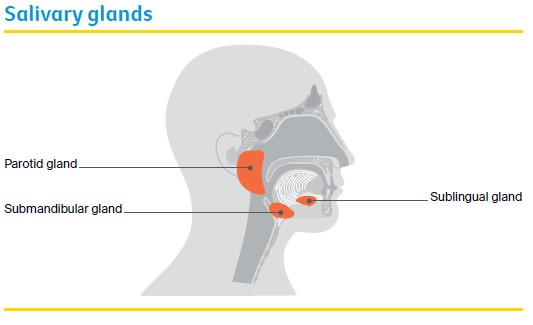
The salivary glands make the watery substance known as saliva. This keeps the mouth moist to help with swallowing and talking and also protects the mouth and teeth. There are three pairs of major salivary glands:
- parotid glands – in front of the ears
- submandibular glands – under the lower jaw
- sublingual glands – under the tongue.
There are also hundreds of smaller glands throughout the lining of the mouth, nose and throat. These are known as minor salivary glands. Cancers can start in the major or minor salivary glands.
When cancer is found in one of the parotid glands, it has often spread from a skin cancer on the head or neck.
Symptoms of salivary gland cancers include:
- swelling or a lump near the ear, jaw or lip, or inside the mouth
- left and right sides of the face or neck looking different
- drooping, numbness or muscle weakness on one side of the face (palsy).
Other cancers in the head and neck area
Cancer can start in the brain, eye, oesophagus, trachea and thyroid, or in bone or muscle of the head and neck. These cancers are not usually classified as head and neck cancers.
The first sign of cancer is often a lump under the skin of the neck or cheek. This can happen when cancer has spread to a lymph node. Your doctors will run tests to work out what type of cancer it is.
It might be a head and neck cancer or it might be a cancer that has spread from elsewhere in the body (e.g. stomach cancer can spread to a lymph node in the neck and will still be considered stomach cancer).
Occasionally, tests show that a cancer in the head and neck started in another part of the body, but it is unclear where it started. This is called cancer of unknown primary (CUP).
How common are head and neck cancers?
According to the Australian Institute of Health and Welfare, almost 6000 people in Australia are diagnosed with a head and neck cancer each year (excluding skin cancers).
This includes about 2100 people with cancer in the mouth or tongue, 1400 with pharyngeal cancer, 570 with laryngeal cancer, 230 with nasal or paranasal sinus cancer and 360 with salivary gland cancer.
Head and neck cancers are more common after the age of 40. Men are about three times more likely than women to develop a head and neck cancer, mainly because of men’s higher smoking and drinking rates.
Aboriginal and Torres Strait Islander peoples are also at increased risk of developing head and neck cancers.
More statistics and trends
Risk factors
The main factors that increase the risk of developing the most common head and neck cancer are:
- smoking tobacco (including cigarettes, cigars and pipes)
- drinking alcohol
- inhaving had human papillomavirus (HPV).
The combined effect of drinking and smoking is much greater than the risk of only drinking or only smoking.
Other risk factors
Other risk factors account for a smaller proportion of head and neck cancers. These include:
- having persistent sores or red or white patches in the mouth
- chewing tobacco, snuff, betel nut, areca nut, paan or gutka
- breathing in asbestos fibres, wood dust or certain chemicals
- poor dental health
- having a weakened immune system
- having had radiation therapy to the head or neck area in the past
- having too much sun exposure (for lip cancer and skin cancer)
- having a parent, child or sibling with head and neck cancer (possibly because you have similar lifestyle factors)
- inheriting a condition linked to head and neck cancer (e.g. Fanconi anaemia, Li-Fraumeni syndrome).
- having had Epstein-Barr Virus (also called glandular fever).
Talk to your doctor if you are worried about any risk factors.
Human papillomavirus (HPV)
HPV is a group of viruses that affect the surface or lining of parts of the body, including the throat, cervix and skin. It is the most common sexually transmitted infection, and may also be transferred in other ways.
About 4 out of 5 people are exposed to HPV in their lifetime and most won't show symptoms or know they've had it.
There are many types of HPV, but only some subtypes are linked to oropharyngeal cancer, which starts in the tonsils and tongue base. This HPV may be spread through oral sex and kissing.
Most HPV infections are cleared by our immune system. In some people, the virus can lie dormant for years and then cause cancer. We still do not understand why this happens.
HPV vaccination can protect you against HPV infection. Talk to your doctor about vaccination or if you are worried about HPV.
Learn more
Health professionals
Your GP will arrange the first tests to assess your symptoms. If these tests do not rule out cancer, you will usually be referred to a specialist, who will arrange further tests.
If head and neck cancer is diagnosed, the specialist will consider treatment options, which will often be discussed with other health professionals at what is known as a multidisciplinary team (MDT) meeting.
During and after treatment, you will see a range of health professionals who specialise in different aspects of your care, including an ENT (ear, nose and throat) specialist, head and neck surgeon, oral and maxillofacial surgeon, reconstructive (plastic) surgeon, dentist and dietician, among others.
It is recommended that complex head and neck cancer is treated in a specialist centre. If you have to travel a long way for treatment, call Cancer Council on 13 11 20 and ask about transport and accommodation assistance that may be available to you.
Finding support
There are many sources of support and information to help you, your family and carers navigate all stages of the cancer experience.
We recommend searching My Cancer Guide for cancer support organisations focussed on head and neck cancer.
Our online glossary may also help to explain unfamiliar medical terms as you learn about the cancer.
Contact cancer support
Understanding Head and Neck Cancers
Download our Understanding Head and Neck Cancers booklet to learn more.
Download now Order for free